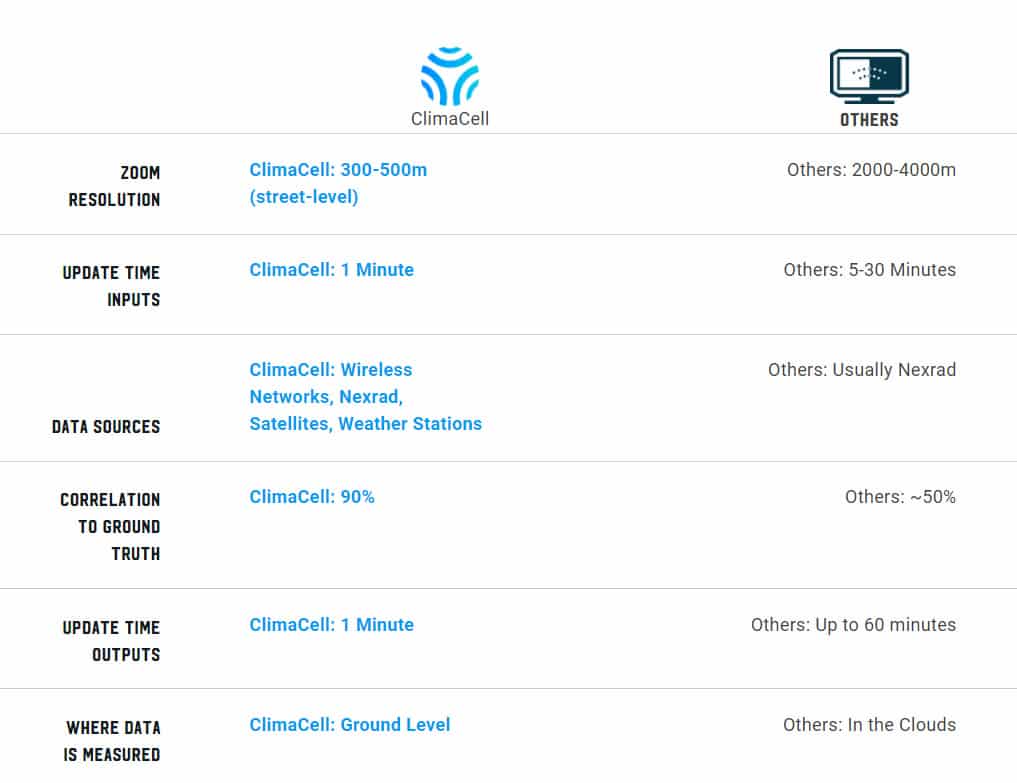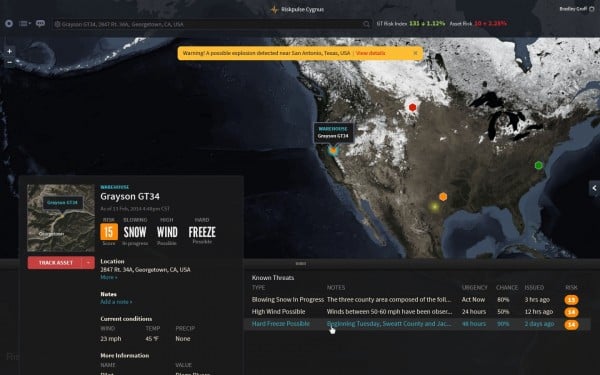6 Startups Improving Weather Forecasting Technology
Table of contents

Everyone likes to talk about the weather. Almost every conversation, at some point, seems to circle back to how much snow they got on the east coast or how little rain they’ve received on the west coast. But the weather is more than idle chit chat. It can cause floods and landslides, help yield a bumper crop or lay waste to a nation’s bread basket. Power companies rely on forecasts to anticipate how much energy the communities they serve might need during a heat wave. Last year, weather-related disasters cost the U.S. economy more than $300 billion. While the local TV meteorologist is an easy scapegoat when it literally rains on your picnic, weather forecasts are getting better despite popular opinion. But that got us to thinking: What sort of weather forecasting technology are startups working on?
How’s the Weather Where You are Now? And Now?
It didn’t take long before we came across ClimaCell, a three-year-old startup out of Boston that has been generating the usual buzz that surrounds young companies with innovative tech and an interesting backstory. In the case of ClimaCell, which has raised $20 million in disclosed funding (and most of that in the last year), the company was founded by three Israeli military veterans who were somehow reunited while all pursuing graduate degrees at Harvard and MIT. Accurate weather forecasting, particularly in the short term and over small spatial scales, can make or break military ops, so the trio decided they could do better than the National Weather Service and NOAA with its high-tech weather satellites.
The solution: Extracting weather data from cellular networks and combining it with historical and traditional weather data from sensors like ground-based weather stations, radars and satellites. Dubbing its hyperlocal, minute-by-minute forecasts as “nowcasting”, ClimaCell developed sophisticated software powered by Nvidia’s GPU hardware to create high-definition weather maps based on the ways weather can affect cellular signals. This sounds a bit like the weather tech being tested by a small satellite company called GeoOptics, which uses distortions in GPS signals to map variables like temperature and humidity to create weather maps. ClimaCell claims its approach doubles the reliability of radars, with 10X the ground resolution.

ClimaCell is flogging its “nowcasting” software platform to a number of industries, including airlines (JetBlue is an investor), on-demand delivery services, construction and insurance companies. For example, in the case of the insurance industry, ClimaCell says its hyperlocal forecasts can validate weather-related claims in minutes because it can actually determine the type and intensity of precipitation street by street. No doubt insurance companies would like to cut down on fraudulent claims—or just make it harder to make the case—by tracking the next hail storm. Consider that a company like State Farm doled out more than $2 billion in damages caused by wind and hail in just 2014.
Update 10/06/2018: Check out our most recent article on ClimaCell titled “ClimaCell Weather Data Comes from Cellular Networks.“
Stationed at Ground Zero
The insurance industry is also a prime target for Understory, a Madison, Wisconsin-based startup founded in 2012 that has raised $9.5 million in disclosed funding. However, instead of software, Understory pins its weather forecasting technology on hardware. It manufactures weather stations called RTis, short for Real Time Instruments, which monitor hail, wind, rain, temperature, pressure, and humidity at ground-level every second of every day. The platform also provides data on wind chill, heat index, evaporation rate, and a number of other weather variables. For insurance companies, Understory claims its hyper-local wind and hail monitoring networks record individual hailstone impacts, wind gusts, and even raindrops in real-time at high resolution. Understory also markets its weather stations to the agricultural industry, saying its network can provide accurate weather updates for each individual field. That potential was enough to convince Monsanto to come aboard as a key investor in 2016.
Update 05/09/2019: Understory has raised $5.25 million in Series B funding to expand internationally across various sectors such as agriculture, insurance, and government. This brings the company’s total funding to $22.2 million to date.
Ensuring Good Weather


Its platform geared for the insurance industry, Dexter, computes a risk score based on the overall likelihood of damage or loss due to weather. In one case, an insurance company with 2,700 properties in Denver determined that only about 1 percent of its policyholders were affected by a hailstorm in May. That allowed the company to focus on specific policies, saving time and resources for things like buying more billboard space featuring 30-year-old photos of its insurance agents. That or big hair is making a comeback outside of Texas.
Update 12/16/2018: In May of 2018, Weather Analytics announced that it acquired and merged with Athenium Inc. Weather Analytics and is investing more than $25 million to build new decision-support software for insurers, enabled by artificial intelligence and computer-vision capabilities. The combined companies are now referred to as Athenium Analytics.
Same Day Delivery


Sunrise works by analyzing a company’s 10-day supply chain schedule and scanning for potential risks, particularly from inclement weather that could cause delays or extreme temperatures that might affect the quality of that order of Branston Original Pickles. It also takes into account factors like natural disasters, infrastructure outages and the occasional pirate activity on the high seas. Xconomy reports that for clients like Anheuser-Busch, Sunrise provides risk scores on about 15,000 shipments each day.
Increasing the Tempo
Founded in 2014, Boulder, Colorado-based Tempo Quest has raised $3.5 million, including a $2.5 million Seed round in December. Like ClimaCell, Tempo Quest has turned to Nvidia to boost its computing power with GPU hardware. Tempo Quest is positioning itself as a sort of weather technology middleman. It takes the weather data collected by satellites, drones, radar, and other sources, crunches it with suped-up software that can produce high-resolution weather forecasts in a fraction of the time, and then provides the data to everyone from the Weather Channel to commodities traders.
This is part of a larger trend of teasing out business intelligence from unorthodox sources, such as we profiled in our article on satellite companies doing geospatial analysis.
Weathering the Storm

Conclusion
As we continue to launch satellites, install smart cameras and put sensors everywhere like refrigerator magnets, the ability to collect data about events like the weather will increase exponentially. In turn, the ability of companies to access and crunch that vast body of information and churn out hyperlocal weather forecasts or predict the decline of the frozen concentrated orange juice market will only improve as algorithms learn to detect patterns like spotting new constellations in the sky.
Indeed, as we recently learned on our deep dive into China’s SenseTime, a company specializing in facial recognition, weather forecasting is already being revolutionized through artificial intelligence. Of course, that only makes sense, as more of the world becomes automated: emerging technologies, like self-driving vehicles or drone delivery, will require that our machines need real-time weather data to do their jobs safely. After that, life will just be a picnic, right?
Sign up to our newsletter to get more of our great research delivered straight to your inbox!
Nanalyze Weekly includes useful insights written by our team of underpaid MBAs, research on new disruptive technology stocks flying under the radar, and summaries of our recent research. Always 100% free.
















I think Weather Analytics is now called Athenium Analytics